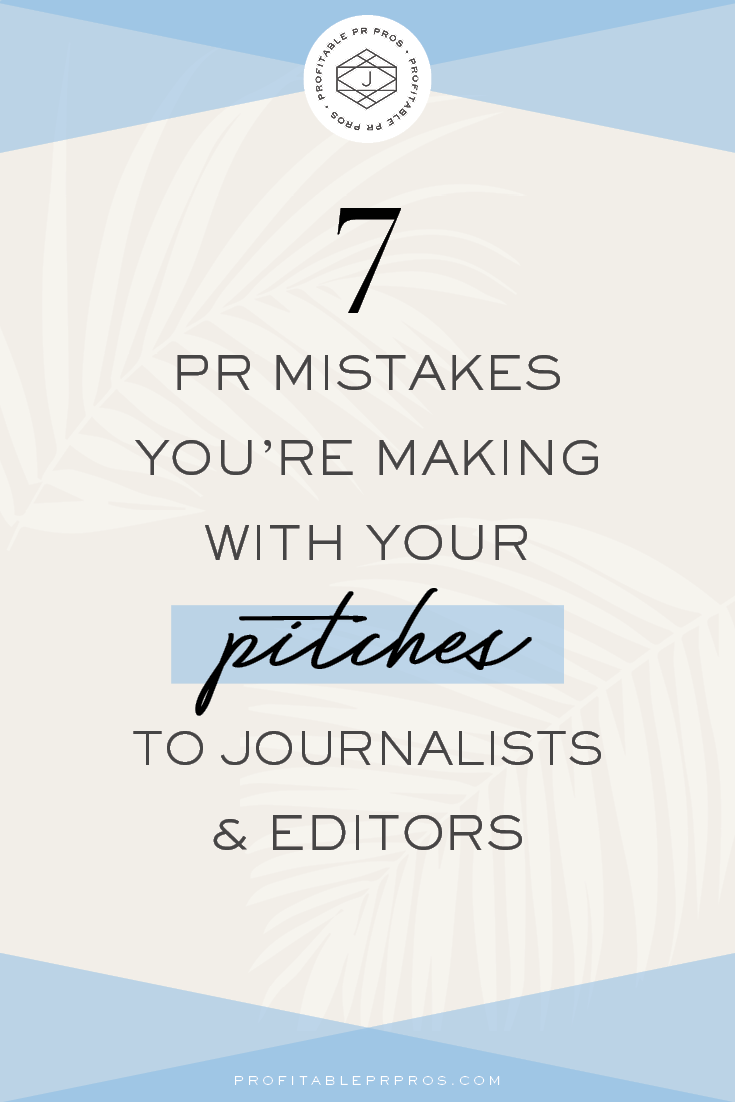7 PR Mistakes You're Making With Your Pitches to Journalists & Editors
Nov 14, 2022
Pitching is the bread and butter of PR, but so much of the process is out of your control! A pitch could not land or a press feature might fall through at any time, so you need to set yourself up for success as much as possible. If you want to land top-tier press for your clients, you need to make sure you’re avoiding the most common pitfalls PR pros make when pitching journalists and editors.
7 Huge PR Mistakes You’re Making With Your Pitches
Every niche is different, but journalists are always looking for the same thing: pitches that inspire them to write and will excite their audience. It’s up to you to deliver that to them with every email you send…so you need to get your pitch-writing skills in check! Here are 7 of the biggest PR mistakes you need to avoid when you reach out to your media contacts.
#1: Writing Pitches that Aren’t Engaging
Your media contacts are just as busy as you are — they don’t have time to read a pitch that’s pages long and full of fluff! Every pitch should tell a story and tell it well in just a few paragraphs. To avoid this major PR mistake, your writing needs to be clear, accurate, and concise on all fronts.
But don’t sacrifice content for a shorter pitch! Your media contacts receive tons of emails every day; you need to stand out in their inbox with an attention-grabbing subject line and a super engaging pitch. They’re far more likely to toss out your pitch if the subject line is forgettable or the pitch itself is poorly written. If you’re not sure how to revamp your subject lines, we have a killer resource inside The Pitch Lab to help you out no matter your niche!
#2: Sending Out Spray-and-Pray Pitches
Lots of PR pros who are just starting out in the industry turn to spray-and-pray pitches as their first strategy. But honestly? Sending out the same pitch to dozens of editors is a huge PR mistake and won’t land you the press your clients need!
Journalists and editors can spot a spray-and-pray pitch from a mile away, and your email will go straight to their recycle bin. Personalizing your pitches and tailoring them to each editor is a mark of respect in media. They should know that your email is for them and only them. It’ll help you establish a personal connection with the editor, which can lead to bigger and better press placements down the road!
#3: Not Nailing the Follow-Up
Following up is a key part of the pitching process. You should always follow up with your media contacts after you’ve pitched them to keep up that line of communication. Check-in with them a day or two after you sent your pitch to make sure they’ve seen it and ask if they need any additional information or assets from your client.
If you’ve already followed up and haven’t received a response, it’s time to move on! If you’re sure your pitch angle is timely, targeted, and relevant to that outlet, consider sending your pitch to a different writer at the publication. Or, you could tweak your pitch slightly and send it out to a media contact at an entirely different outlet.
The follow-up process doesn’t end when your client’s press feature is published! Once the article is live, you should only reach out to your contact to give them your thanks and show your client’s appreciation. Never follow up with unnecessary edits you want them to make, like requesting updated photography, links, and SEO keywords or phrases. They wrote their article the way they did for a reason — trust them to do their job and move on!
Related: 6 PR Strategies To Keep Your Pitches Fresh (Even When There’s No News)
#4: Including Attachments (Yes, It’s a PR Mistake!)
Seriously! Including attachments is one of the easiest PR mistakes you can make. It’s tempting to send off a super-short pitch with tons of extra information in the attachments, but it’s not going to encourage an editor to give you the press feature.
Instead, include that additional information right in the body of your email so your media contact has all the crucial info right from the start. Many of them read their emails on the go — pitches with attachments that take forever to load are an automatic delete for some editors. Plus, attachments can get your email rerouted to their spam folder!
If you need to attach a document with additional information, send the document via a Dropbox or Google Drive link. Before you send your pitch, double-check that sharing permissions are updated so the journalist has no issue accessing the file. We have a short tutorial in The Pitch Lab that takes you step-by-step through Google’s sharing permissions if you’re not familiar with the process.
#5: Reaching Out to the Wrong Journalists
This is one of the biggest PR mistakes I see all the time! A killer pitch is no good if it doesn’t end up in the right editor’s inbox. You should always do your research before pitching to make sure the outlet lines up with your client’s target audience. Lots of journalists have been shifting between outlets and beats lately, so double-check that you’re pitching the proper journalist, too.
When you do send out your pitches, be as targeted as possible. You already know that reaching out to as many people as possible isn’t an effective way to land press. Make sure the journalists that you are pitching are genuinely interested in your client’s niche, product, or service, and haven’t covered something similar before.
Related: 8 Public Relations Characteristics all Comms Pros Need to Be Successful
#6: Asking for Too Many SEO Specifics
Remember: you’re the PR pro, not the journalist. Including a few SEO keywords or phrases in your pitches is a great way to pop up in editors’ inboxes, but that’s as far as it goes! Asking journalists to use certain keywords or phrases in their article is not okay.
An editor is at a publication to write quality articles for their readers…not repeat your client’s marketing materials verbatim! Most times, journalists will be directed to use certain SEO keywords or phrases in their piece by their outlet’s SEO team. Requesting certain words (whether at the start or in your follow-up) can get your pitch rejected.
This goes for SEO links, too! Asking for specific links could be considered another PR mistake all on its own. Outlets have their own standards for SEO linking, especially regarding affiliate marketing — you can include your client’s website and affiliate links in your pitch, but what ends up in the article is determined by the outlet.
And if you want to learn more about effectively incorporating affiliate marketing into your pitches, we have two masterclasses inside The Pitch Lab to help you out!
#7: Pitching Just to Pitch
I know what you’re thinking: pitching is its own PR mistake?! And it definitely is…but only in certain situations. You should always be discerning with the pitches that you send out to the media.
You don’t have to pitch every bit of news coming from your client’s business! Some things aren’t worthy of a dedicated news story or would be better suited for another time of year. Ask yourself if a pitch is truly timely, relevant, and targeted before sending it out.
Jumping on trends that don’t fit your client just to get into that conversation is one of the most common PR mistakes. Newsjacking is a great strategy, but it’s not effective if the trend itself is disconnected from your client! Pitching for trends that align with your client’s products, services, and brand identity should always be your newsjacking priority.
Avoiding these PR mistakes is the key to setting yourself and your pitches up for success with journalists in your niche. Breaking old habits can be a tough transition (no more attachments!), but it will seriously elevate the quality of your pitches…and editors will take notice. You’ll start landing consistent top-tier press placements in no time!








